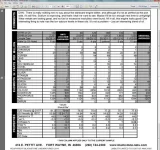REBrueckner
Legendary Member
- Joined
- Apr 24, 2005
- Messages
- 4,168
- Status
- OWNER - I own a Hatteras Yacht
- Hatteras Model
- 48' YACHT FISHERMAN (1972 - 1975)
Not that anyone needs convincing about lube oil analyses, but here is a current unfolding story.
During the survey of 1976 Cummins 903 VTA's we got an oil analysis on one engine with the following SEVERE readings. We do not know the hours on the oil, but it's likely been sitting mostly unsued for three or four years. In the Chesapeake Bay area. The other engine had all normal readings:[all in parts per million]
Iron, 456
Aluminum 70
Copper 200
Sodium 453
Other readings had some high results warranting 'monitor' .
So I called the lab and spoke to an ex navy mechanic, now working for the lab on analysis of test results. Here are the notes I made:
" Recommends NOT running this engine as test results indicate SEVERE wear and existing engine damage. The wear metals indicate bearing and or bushing wear and the extremely high sodium suggest s either antifreeze and/or raw water intrusion. Heat exchanger as well as head gasket leaks could be at fault.
The standards against which these readings are based are statistical for a range of Cummins engines not specifically for Cummins VTA 903 nor specifically marine engines. The indicators in the report are based on standard deviations for all Cummins engines they have tested. [This is common, not unusual.#]
These wear metal [iron, aluminum and copper] and contaminant metals [sodium] are entirely out of normal range and running the engine for the 50 hours I mentioned back to CT is ill advised. The lab normally see potassium and sodium levels at about the same levels, as is presented in the port engine.
Total Base Number of about 6 [under fluid properties] reading is normal and indicates the acid control of the oil, the alkalinity of the oil, remains in the satisfactory range. This oil [Rotella T 15W 40] originates with a TBN of 10."
So I called back and asked: "Do you think the wear metals, the first three severe readings, and the sodium level are related?
"Sure: Without any doubt the extreme sodium reading has caused the out of normal wear readings.
What about running that engine for about five hours to get to a repair facility?
" Can you have the boat towed?' OMG!!!!
So I called the prospective buyer, a friend, and told him: If you plan to run to the repair marina, we should run on one engine after leaving dockside. We can restart the damaged engine for maneuvering for a few minutes to get dockside at the repair facility if required.
Next step: we get advice from a certified Cummins mechanic at the reapir facility.
# I reported similar baseline comparisons for my own 8V71TI oil analyses [different analysis laboratory] maybe 6 or 8 years ago in these forums. Turned out back then, and still seems the case, such engine wear and contaminant levels are proprietary.
Will post subsequent developments as they unfold.
Comments, insights welcome.
During the survey of 1976 Cummins 903 VTA's we got an oil analysis on one engine with the following SEVERE readings. We do not know the hours on the oil, but it's likely been sitting mostly unsued for three or four years. In the Chesapeake Bay area. The other engine had all normal readings:[all in parts per million]
Iron, 456
Aluminum 70
Copper 200
Sodium 453
Other readings had some high results warranting 'monitor' .
So I called the lab and spoke to an ex navy mechanic, now working for the lab on analysis of test results. Here are the notes I made:
" Recommends NOT running this engine as test results indicate SEVERE wear and existing engine damage. The wear metals indicate bearing and or bushing wear and the extremely high sodium suggest s either antifreeze and/or raw water intrusion. Heat exchanger as well as head gasket leaks could be at fault.
The standards against which these readings are based are statistical for a range of Cummins engines not specifically for Cummins VTA 903 nor specifically marine engines. The indicators in the report are based on standard deviations for all Cummins engines they have tested. [This is common, not unusual.#]
These wear metal [iron, aluminum and copper] and contaminant metals [sodium] are entirely out of normal range and running the engine for the 50 hours I mentioned back to CT is ill advised. The lab normally see potassium and sodium levels at about the same levels, as is presented in the port engine.
Total Base Number of about 6 [under fluid properties] reading is normal and indicates the acid control of the oil, the alkalinity of the oil, remains in the satisfactory range. This oil [Rotella T 15W 40] originates with a TBN of 10."
So I called back and asked: "Do you think the wear metals, the first three severe readings, and the sodium level are related?
"Sure: Without any doubt the extreme sodium reading has caused the out of normal wear readings.
What about running that engine for about five hours to get to a repair facility?
" Can you have the boat towed?' OMG!!!!
So I called the prospective buyer, a friend, and told him: If you plan to run to the repair marina, we should run on one engine after leaving dockside. We can restart the damaged engine for maneuvering for a few minutes to get dockside at the repair facility if required.
Next step: we get advice from a certified Cummins mechanic at the reapir facility.
# I reported similar baseline comparisons for my own 8V71TI oil analyses [different analysis laboratory] maybe 6 or 8 years ago in these forums. Turned out back then, and still seems the case, such engine wear and contaminant levels are proprietary.
Will post subsequent developments as they unfold.
Comments, insights welcome.
Last edited:


